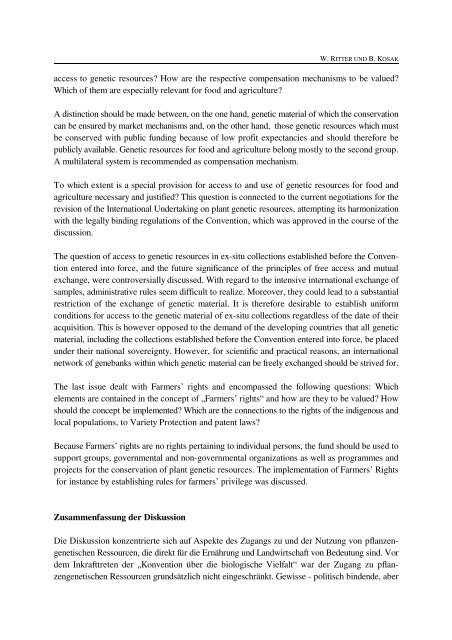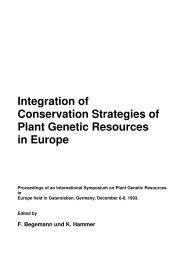Zugang zu Pflanzengenetischen Ressourcen für die ... - Genres
Zugang zu Pflanzengenetischen Ressourcen für die ... - Genres
Zugang zu Pflanzengenetischen Ressourcen für die ... - Genres
Erfolgreiche ePaper selbst erstellen
Machen Sie aus Ihren PDF Publikationen ein blätterbares Flipbook mit unserer einzigartigen Google optimierten e-Paper Software.
W. RITTER UND B. KOSAK<br />
access to genetic resources? How are the respective compensation mechanisms to be valued?<br />
Which of them are especially relevant for food and agriculture?<br />
A distinction should be made between, on the one hand, genetic material of which the conservation<br />
can be ensured by market mechanisms and, on the other hand, those genetic resources which must<br />
be conserved with public funding because of low profit expectancies and should therefore be<br />
publicly available. Genetic resources for food and agriculture belong mostly to the second group.<br />
A multilateral system is recommended as compensation mechanism.<br />
To which extent is a special provision for access to and use of genetic resources for food and<br />
agriculture necessary and justified? This question is connected to the current negotiations for the<br />
revision of the International Undertaking on plant genetic resources, attempting its harmonization<br />
with the legally binding regulations of the Convention, which was approved in the course of the<br />
discussion.<br />
The question of access to genetic resources in ex-situ collections established before the Convention<br />
entered into force, and the future significance of the principles of free access and mutual<br />
exchange, were controversially discussed. With regard to the intensive international exchange of<br />
samples, administrative rules seem difficult to realize. Moreover, they could lead to a substantial<br />
restriction of the exchange of genetic material. It is therefore desirable to establish uniform<br />
conditions for access to the genetic material of ex-situ collections regardless of the date of their<br />
acquisition. This is however opposed to the demand of the developing countries that all genetic<br />
material, including the collections established before the Convention entered into force, be placed<br />
under their national sovereignty. However, for scientific and practical reasons, an international<br />
network of genebanks within which genetic material can be freely exchanged should be strived for.<br />
The last issue dealt with Farmers’ rights and encompassed the following questions: Which<br />
elements are contained in the concept of „Farmers’ rights“ and how are they to be valued? How<br />
should the concept be implemented? Which are the connections to the rights of the indigenous and<br />
local populations, to Variety Protection and patent laws?<br />
Because Farmers’ rights are no rights pertaining to individual persons, the fund should be used to<br />
support groups, governmental and non-governmental organizations as well as programmes and<br />
projects for the conservation of plant genetic resources. The implementation of Farmers’ Rights<br />
for instance by establishing rules for farmers’ privilege was discussed.<br />
Zusammenfassung der Diskussion<br />
Die Diskussion konzentrierte sich auf Aspekte des <strong>Zugang</strong>s <strong>zu</strong> und der Nut<strong>zu</strong>ng von pflanzengenetischen<br />
<strong>Ressourcen</strong>, <strong>die</strong> direkt <strong>für</strong> <strong>die</strong> Ernährung und Landwirtschaft von Bedeutung sind. Vor<br />
dem Inkrafttreten der „Konvention über <strong>die</strong> biologische Vielfalt“ war der <strong>Zugang</strong> <strong>zu</strong> pflanzengenetischen<br />
<strong>Ressourcen</strong> grundsätzlich nicht eingeschränkt. Gewisse - politisch bindende, aber










